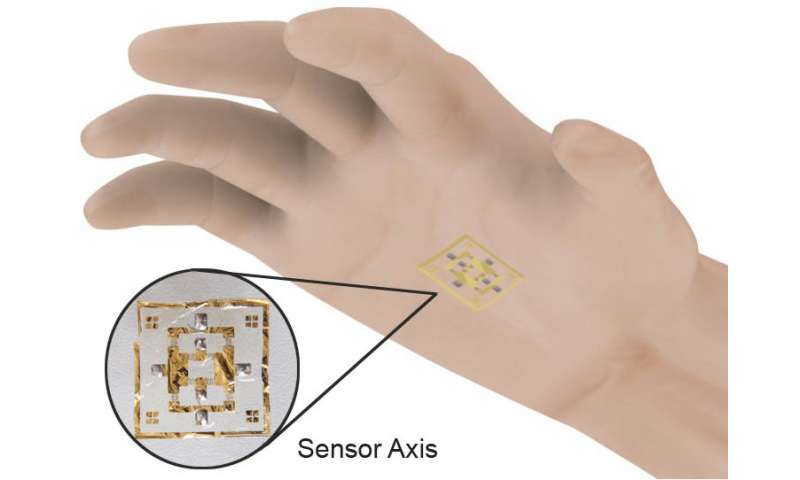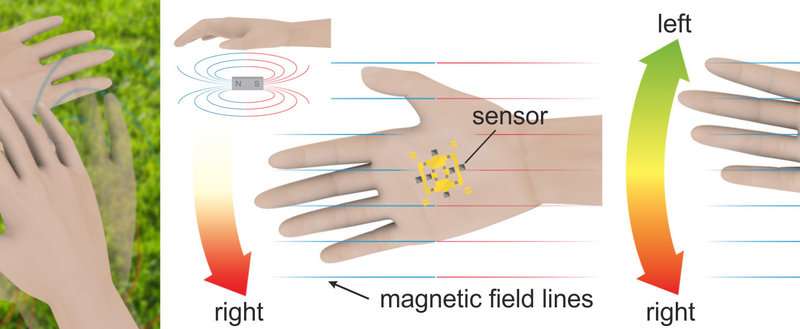January 22, 2018 report
E-skin for manipulating virtual objects without touching them

A team of researchers from Germany and Austria has developed a type of e-skin that allows a wearer to control virtual objects without touching them. In their paper published on the open access site Science Advances, the group describes their e-skin, how it works, and the applications they believe would benefit from its use.
As the researchers note, current VR gear is cumbersome, particularly for fully immersive systems that require the use of gloves. VR gear, they also note, is based on line-of-site activities—users cannot move or control objects that they cannot "see." To overcome these problems, they have developed a type of e-skin based on magnetics for moving virtual objects that cannot be seen without touching them.
The e-skin, or magnetosensitive skin, as the team calls it, is a magnetic sensor sandwiched between very thin films. It looks like a partially see-through Band-Aid but is just 3.5 microns thick. Due to its thinness, the wearer is unlikely to notice it.
The e-skin can be applied to the palm, fingertips and other parts of the hand. The wearer uses it near a magnetized device such as a ring-shaped plastic "dial," and can control a light via subtle twisting hand movements. In their demonstration, the system was connected wirelessly to a computer that was coded to note changes in angle from 0 to 180 degrees as sensed by the strength of the magnetic force. As the hand was turned through a few small degrees of motion, the virtual lamp glowed brighter. The researchers also tested the concept by creating a magnetized virtual keyboard strapped to the wrist. With the e-skin applied to the fingertip on the opposite arm, the user was able to type letters without having to touch the keypad.
The researchers suggest their e-skin could be useful for more than just virtual, or augmented reality applications. They believe it could also be useful for medical or security applications. They are also planning to continue their research to see if they can make it work based on the Earth's magnetic field, which would allow the e-skin to be used for positioning applications.
-

Schematics revealing a 2D magnetic field sensor mounted on a palm. Credit: Helmholtz-Zentrum Dresden-Rossendorf e.V. -

Touchless manipulation of virtual objects using a 2D sensor interacting with magnetic fields. By changing the position of the hand in the magnetic field, the state or property of a virtual object can be controlled. Credit: Helmholtz-Zentrum Dresden-Rossendorf e.V.
More information: Gilbert Santiago Cañón Bermúdez et al. Magnetosensitive e-skins with directional perception for augmented reality, Science Advances (2018). DOI: 10.1126/sciadv.aao2623
Abstract
Electronic skins equipped with artificial receptors are able to extend our perception beyond the modalities that have naturally evolved. These synthetic receptors offer complimentary information on our surroundings and endow us with novel means of manipulating physical or even virtual objects. We realize highly compliant magnetosensitive skins with directional perception that enable magnetic cognition, body position tracking, and touchless object manipulation. Transfer printing of eight high-performance spin valve sensors arranged into two Wheatstone bridges onto 1.7-μm-thick polyimide foils ensures mechanical imperceptibility. This resembles a new class of interactive devices extracting information from the surroundings through magnetic tags. We demonstrate this concept in augmented reality systems with virtual knob-turning functions and the operation of virtual dialing pads, based on the interaction with magnetic fields. This technology will enable a cornucopia of applications from navigation, motion tracking in robotics, regenerative medicine, and sports and gaming to interaction in supplemented reality.
© 2018 Tech Xplore















